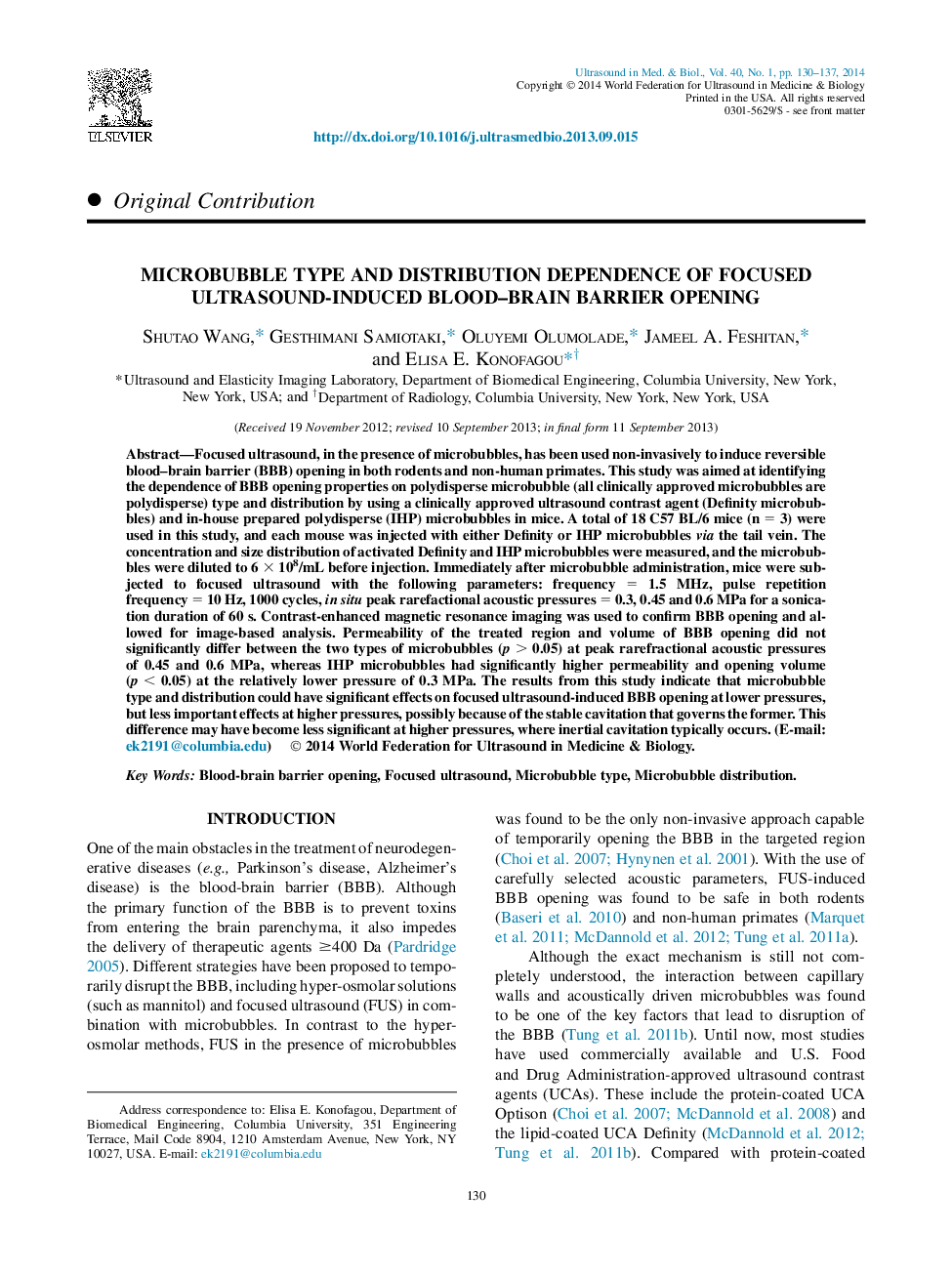| کد مقاله | کد نشریه | سال انتشار | مقاله انگلیسی | نسخه تمام متن |
|---|---|---|---|---|
| 1760669 | 1019620 | 2014 | 8 صفحه PDF | دانلود رایگان |
عنوان انگلیسی مقاله ISI
Microbubble Type and Distribution Dependence of Focused Ultrasound-Induced Blood-Brain Barrier Opening
ترجمه فارسی عنوان
نوع میکروبروکوب و وابستگی توزیع انفجار ساب مغز ایجاد شده توسط سونوگرافی متمرکز شده
دانلود مقاله + سفارش ترجمه
دانلود مقاله ISI انگلیسی
رایگان برای ایرانیان
کلمات کلیدی
باز کردن مانع از خون مغزی، سونوگرافی متمرکز نوع میکروبابابل، توزیع میکروبابابل،
موضوعات مرتبط
مهندسی و علوم پایه
فیزیک و نجوم
آکوستیک و فرا صوت
چکیده انگلیسی
Focused ultrasound, in the presence of microbubbles, has been used non-invasively to induce reversible blood-brain barrier (BBB) opening in both rodents and non-human primates. This study was aimed at identifying the dependence of BBB opening properties on polydisperse microbubble (all clinically approved microbubbles are polydisperse) type and distribution by using a clinically approved ultrasound contrast agent (Definity microbubbles) and in-house prepared polydisperse (IHP) microbubbles in mice. A total of 18 C57 BL/6 mice (n = 3) were used in this study, and each mouse was injected with either Definity or IHP microbubbles via the tail vein. The concentration and size distribution of activated Definity and IHP microbubbles were measured, and the microbubbles were diluted to 6 Ã 108/mL before injection. Immediately after microbubble administration, mice were subjected to focused ultrasound with the following parameters: frequency = 1.5 MHz, pulse repetition frequency = 10 Hz, 1000 cycles, in situ peak rarefactional acoustic pressures = 0.3, 0.45 and 0.6 MPa for a sonication duration of 60 s. Contrast-enhanced magnetic resonance imaging was used to confirm BBB opening and allowed for image-based analysis. Permeability of the treated region and volume of BBB opening did not significantly differ between the two types of microbubbles (p > 0.05) at peak rarefractional acoustic pressures of 0.45 and 0.6 MPa, whereas IHP microbubbles had significantly higher permeability and opening volume (p < 0.05) at the relatively lower pressure of 0.3 MPa. The results from this study indicate that microbubble type and distribution could have significant effects on focused ultrasound-induced BBB opening at lower pressures, but less important effects at higher pressures, possibly because of the stable cavitation that governs the former. This difference may have become less significant at higher pressures, where inertial cavitation typically occurs.
ناشر
Database: Elsevier - ScienceDirect (ساینس دایرکت)
Journal: Ultrasound in Medicine & Biology - Volume 40, Issue 1, January 2014, Pages 130-137
Journal: Ultrasound in Medicine & Biology - Volume 40, Issue 1, January 2014, Pages 130-137
نویسندگان
Shutao Wang, Gesthimani Samiotaki, Oluyemi Olumolade, Jameel A. Feshitan, Elisa E. Konofagou,
